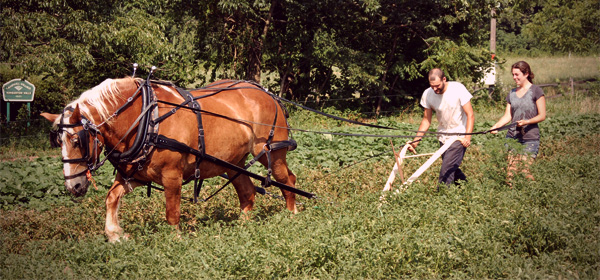story by Ariela RoseCan farming serve as therapy for those afflicted with cognitive disabilities? The answer’s not as far out there as you might think. In fact, it’s just an hour from the bustling streets of Philadelphia on the serene farmland of Chester County’s Camphill Village Kimberton Hills. The planned community is home to over 100 individuals, 40 of whom are diagnosed with a variety of cognitive disabilities—including autism, Down Syndrome and brain trauma. Rather than isolating those with special needs, the community’s success depends upon the interactions of all community members through biodynamic agriculture. In work teams, the residents of Kimberton Hills educate one another in daily give-and-take through which the term “disabled” becomes a misnomer.
Austrian pediatrician Karl Koenig established the first Camphill Village in Scotland during the 1940s as a social community where the abilities—and not the handicaps—of those diagnosed with special needs would be the focus. The movement has since spread to 100 villages in 20 countries on four continents, each one using agriculture as one form of therapy. At Kimberton Hills, the farm work has aided in easing the often-debilitating mental and physical ailments of residents, who are referred to as villagers.
Kimberton Hills’ combined 432 acres are divided between a 250-acre raw milk dairy, a 10- to 15-acre CSA garden, a one-third-acre herb garden, a craft house, a wood shop, a cafe and shared group homes. Serene, blue mountains serve as backdrop to rolling hills and soil kept fertile through holistic land husbandry. It exudes a calm that explains why many of the villagers have stayed for more than two decades.
The land was a gift to the Camphill organization by Alaric and Mabel Pew Myrin, a couple passionate about biodynamics, a method ofsustainable farming that values land as a living organism. In that spirit, each of Camphill’s villagers are given a job on the farm that connects them with the land. Work teams of villagers are guided by long- and short-term volunteers with whom they also share group homes. Rather than a formal work-training program, villagers gain skills through daily repetition.
“The simplest way to put it,” says Bernadette Kovaleski, Kimberton Hills’ development and PR director, “is that a healthy environment includes the people, the land, the animals, the food that you’re growing, the air that you breathe, the complete circle around you.”
Residents may plant in the 150-member CSA garden, care for golden brown cows at the dairy, bake breads in the cafe’s wood-fired oven and more. The rhythm of daily activities is guided by the biodynamic principle of a self-regulating ecosystem that supports the farm and its local community. Kimberton Hills relies heavily on the fruits of its residents’ labor to not only support village life, but also to supply raw milk to neighboring businesses Kimberton Whole Foods and Seven Stars Farm.
“What we especially like is that for the people with disabilities who are living here, it’s not that we’re providing a service or program for them,” says Kovaleski. “They’re making just as much of a difference in the world as anyone else. It’s a great model to show what is possible.”
To learn how to volunteer or to join the community, visit camphillkimberton.org.



